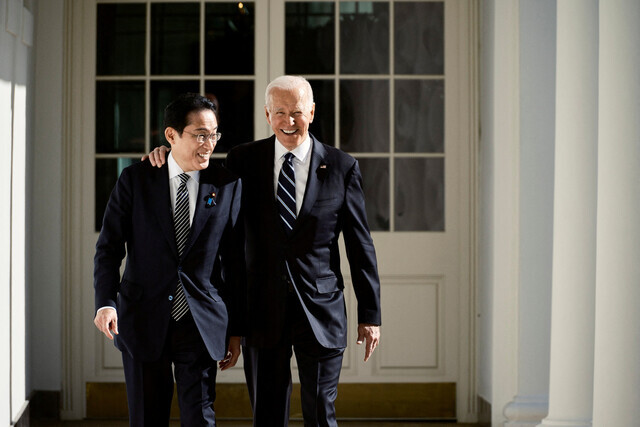hankyoreh
Links to other country sites 다른 나라 사이트 링크
[Column] Why Yoon should pump the brakes on visits to Japan, US


In 2010, Japan was brought to its knees by China. That February, China overtook Japan and became the world’s second-largest economy. In September of that year, the Japan Coast Guard arrested a Chinese fishing boat captain who collided with one of their patrol boats near the disputed Senkaku (Diaoyu) Islands.
In retaliation, China arrested four Japanese nationals on espionage charges, canceled the summit that was to be held between the leaders of the two countries, and blocked rare earth exports to Japan.
Since Japan relied heavily on China for its rare earths supply — with China supplying 90% of all essential rare earths key to the production of high-tech electronics — Japan had to release the Chinese captain after a mere few days.
In 2012, large-scale anti-Japan protests and boycotts took place daily in China in protest of the Japanese government’s “nationalization” of the disputed islands. China’s hard-line diplomacy ruined any chances of the then-ruling Democratic Party of Japan’s hopes of creating a “diplomacy independent from the US” and the establishment of an “Asian community.”
China chose the hierarchical power that comes with Sinocentrism rather than aiming for equal relations with other Asian countries. It significantly strengthened its military forces and began to race toward an Asian hegemony by showing off its military power in the South China Sea, the East China Sea and the Taiwan Strait.
At a time in which Japan was failing to fulfill hopes of an “Asian community” in 2012, Prime Minister Shinzo Abe returned to power. Abe began to create a many-layered security network that linked Japan with major countries beyond Asia to keep China’s expansion in check in what amounted to Japan’s Indo-Pacific strategy.
In 2015, Japan changed its interpretation of its Constitution so that the Japan Self-Defense Forces could conduct military operations with the US anywhere in the world. Despite Abe’s assassination, in December 2022, the Japanese government revised three major security documents so as to possess the ability to preemptively strike enemy bases if an attack was deemed imminent, and decided to double its defense spending over the coming five years.
In essence, Japan has invalidated its pacifist Constitution to reappear as a military powerhouse.
At the US-Japan summit held on Jan. 13, US President Joe Biden voiced full support for Japan strengthening its military power. With the US struggling to keep China in check, it has decided to cooperate in all fields — such as semiconductors, space, nuclear power and energy — with Japan, a “military power.”
Japan’s diplomatic strategy has steadily secured victories by dealing with China’s acts of hegemonism, North Korea’s nuclear weapon threat, and Russia’s invasion of Ukraine. Japan’s status vis a vie its alliance with Japan has been elevated, and it has created (and leads) a security network with NATO, India, and Australia, and has re-established the Anglo-Japanese alliance. In an era showcasing the resurgence of empires, Japan has demonstrated its position as a major power. In this process, its economic relations with China have not faltered either.
What was South Korea’s strategy during this time? It went back and forth between extremes.
Park Geun-hye climbed the Tiananmen watchtower with Chinese President Xi Jinping, but when China did not help resolve the North Korean nuclear weapons issue, she rushed to deploy THAAD (Terminal High Altitude Area Defense) and to make a deal on the Korea-Japan comfort women issue.
The Moon Jae-in administration tried to move President Donald Trump of the US and strengthen inter-Korean relations, but had to admit defeat when the North Korea-US summit ended with nothing. The administration butted heads with the Abe faction over the future of the Korean Peninsula and Korean-Japan history, and the conflict between the two countries deepened with Japan’s export regulations and the termination of the Korea-Japan GSOMIA (General Security of Military Information Agreement).
President Yoon Suk-yeol, who has been calling for the rapid improvement of Korea-Japan relations and for the strengthening of cooperation between the two countries, is slated to announce a final plan for resolving the issue of Japan’s wartime forced mobilization of Korean laborers and is pushing for a series of visits to Japan and the US in February and March.
Yoon wants to show off the achievements that the Moon Jae-in government failed to obtain to his supporters in Tokyo and Washington to improve Korea-Japan relations and strengthen security through cooperation between South Korea and Japan.
A “war-free era” ended as China pursued hegemony without being properly prepared, with North Korea pouncing on the US-China conflict to begin its nuclear saber-rattling in earnest, and Russia invaded Ukraine. All countries are playing an extremely selfish game in their own national interest.
In such a situation, cooperation between South Korea, the US and Japan is necessary to improve the security situation without going down the path of all-around nuclear armament. At the same time, South Korea should utilize this situation to establish a clear strategy for what the country needs to pursue in the long and short term.
South Korea must make its voice heard within its trilateral alliance with the US and Japan so as to prevent Japan’s rearmament from heading in a dangerous direction, and must put China back on track toward the goal of denuclearizing North Korea, leveraging its position to prevent the outbreak of war in the Taiwan Strait.
Korea holds an important key to East Asia’s security and economy. Korea must secure its place in the rapidly changing high-tech and economic order by demanding that it remain on equal footing with Japan and the US, instead of being relegated to a dependent variable.
The Yoon administration is focusing too much on the US and Japan. Has Yoon been calling on the US and Japan to take Korea’s approach into consideration when thinking about past issues? Has the president made a sincere effort to persuade the victims of forced labor and the public of his administration’s plan for resolution to the issue?
Since Japan has joined hands firmly with the US to construct the current situation, it can sit back and relax and decline to make concessions to an impatient Korea. Tokyo is still adamantly refusing to apologize to victims of forced labor and the relevant companies are refusing to participate in compensation.
Former President Lee Myung-back pushed for a GSOMIA deal with Japan in 2012, but when the public opinion grew foul, he canceled the signing 50 minutes before the event. In August 2012, he tried to boost his approval rating by stoking anti-Japanese sentiment with a visit to Dokdo and demanding an “apology from the emperor,” which only drove Korea-Japan relations into a quagmire. This example is one that Yoon should be wary of.
Please direct questions or comments to [english@hani.co.kr]

Editorial・opinion
![[Column] Park Geun-hye déjà vu in Yoon Suk-yeol [Column] Park Geun-hye déjà vu in Yoon Suk-yeol](https://flexible.img.hani.co.kr/flexible/normal/500/300/imgdb/original/2024/0424/651713945113788.jpg) [Column] Park Geun-hye déjà vu in Yoon Suk-yeol
[Column] Park Geun-hye déjà vu in Yoon Suk-yeol![[Editorial] New weight of N. Korea’s nuclear threats makes dialogue all the more urgent [Editorial] New weight of N. Korea’s nuclear threats makes dialogue all the more urgent](https://flexible.img.hani.co.kr/flexible/normal/500/300/imgdb/original/2024/0424/7317139454662664.jpg) [Editorial] New weight of N. Korea’s nuclear threats makes dialogue all the more urgent
[Editorial] New weight of N. Korea’s nuclear threats makes dialogue all the more urgent- [Guest essay] The real reason Korea’s new right wants to dub Rhee a founding father
- [Column] ‘Choson’: Is it time we start referring to N. Korea in its own terms?
- [Editorial] Japan’s rewriting of history with Korea has gone too far
- [Column] The president’s questionable capacity for dialogue
- [Column] Are chaebol firms just pizza pies for families to divvy up as they please?
- [Column] Has Korea, too, crossed the Rubicon on China?
- [Correspondent’s column] In Japan’s alliance with US, echoes of its past alliances with UK
- [Editorial] Does Yoon think the Korean public is wrong?
Most viewed articles
- 1‘We must say no’: Seoul defense chief on Korean, USFK involvement in hypothetical Taiwan crisis
- 2N. Korean delegation’s trip to Iran shows how Pyongyang is leveraging ties with Moscow
- 3‘Weddingflation’ breaks the bank for Korean couples-to-be
- 4Korea sees more deaths than births for 52nd consecutive month in February
- 5[Column] Park Geun-hye déjà vu in Yoon Suk-yeol
- 6Will NewJeans end up collateral damage in internal feud at K-pop juggernaut Hybe?
- 7[Column] Has Korea, too, crossed the Rubicon on China?
- 8Amnesty notes ‘erosion’ of freedom of expression in Korea in annual human rights report
- 9Samsung barricades office as unionized workers strike for better conditions
- 10[Column] The clock is ticking for Korea’s first lady